From metallic silicon to SSD: how OCZ solid-state drives are created
Hi, Geektimes! Many users of SSDs often wonder: how and where do SSDs actually produce? How complex is this technological process? And if the general principles of assembly are known to some, not everyone is able to look behind the scenes of production. Today we will tell you how to create SSDs, and take a short excursion to the OCZ plant in Taiwan.
Before you - metallic silicon. That it is the basis of the production of chips, including components for solid-state drives. Now it is often made by a carbothermic method, which is patented by Russian scientists, using in the process ore-thermal furnaces. A ton of such good costs from two to three thousand euros. In the huge furnaces in the factories get metallic silicon, the purity of which ranges from 98.5%, as well as silicon dust. The latter is used, as a rule, in building mixtures, so that it interests us little.

Technical silicon is obtained by reducing coke with a melt of SiO2, and the temperature reaches 1800 degrees Celsius. Thus, silicon is produced with a purity of 99.9%, where the rest is carbon and metals.
')
But for the production of electronic components, we need the so-called electron silicon, “the purest diamond” among silicon. Technical silicon is chlorinated and trichlorosilane (SiHCl3) is obtained. After it is cleaned, we have electron silicon at the outlet, in which the concentration of impurities is very low — as a rule, 0.0000001%. Electron silicon is melted into single crystals, which are subsequently cut into plates with a diamond saw.
This is what one such single crystal looks like, the weight of which can reach one centner, or even more.
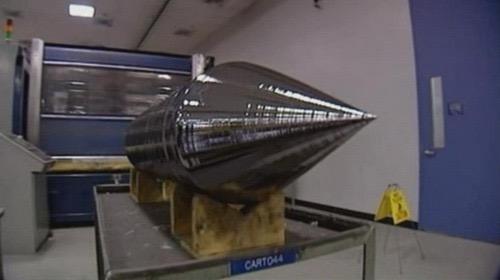
Schematically, the cutting looks like this, saw, believe me, is very sharp:
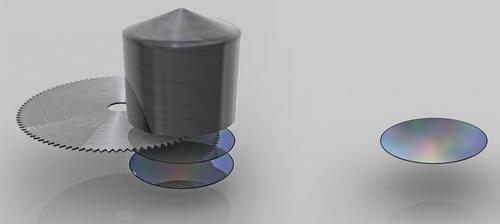
After that, the plates are polished and made even so that they shine straight in the literal sense. But let's not go deep into the subtleties of production, especially since we simply do not have enough ink to describe all the processes. To demonstrate all this in practice, it is better to look at the production with your own eyes. At the OCZ factory.
Until our “plane” landed in Taiwan, let's first see how the process of manufacturing solid-state drives in OCZ is structured. Before the disk is in the factory for assembly, it is designed, the design is approved, tested, and many concepts are created. The diagram below illustrates the main stages of the design of the technological part.
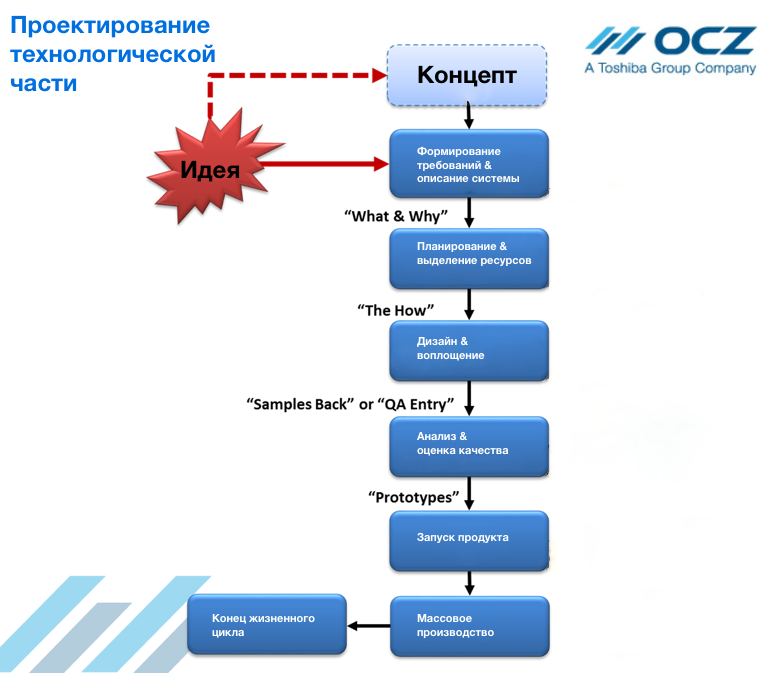
As in the case of any product, the development of SSD begins with an idea that may not necessarily be the creation of a completely new model of drive. This could be an update to the existing lineup with a new NAND, its completion with a larger capacity version, another form factor, new software, and so on. At the zero stage, the idea is ready to become a concept; it only needs to be “pushed” in the right direction. This will help the document, which usually consists of 1-2 pages, which contains a brief description of the product and the purpose of its creation.
Once the concept is settled, marketing and engineering teams join forces. Both are very important, because the drive must not only be sold, but also be reliable and modern, combining the latest achievements in the industry. The work takes about three weeks and ends with the formation of requirements and a description of the system. If the latter cannot be formulated, the product returns to the concept stage.
At the second stage, OCZ plans and allocates resources for the project, only after that work on its implementation begins. Two important documents that are needed for this are marketing requirements and an engineering conclusion. In general, the second stage is one of the most important, since it requires teams to work together and work out all aspects and subtleties, including the budget. It depends on the project plan and budget where the company will send its hundreds of thousands (or even millions) of dollars, so there can be no miscalculation here. The second phase depends both on the product and on the teams that work on it: it usually takes from one to three months (the last - in the case of the development of a completely new drive).
If the project budget is allocated, OCZ moves to the third phase, where most of the work of engineers has already been done. The main goal is to create the first working prototype so that it can be tested.
While the engineers are busy with their work, the rest of the teams perform their own tasks and prepare everything for the production of prototypes (at this stage suppliers are selected, preliminary specifications and marketing materials are developed). The length of the development and implementation phase largely depends on the product, but even a drive using an existing controller can be stuck on it for a whole year. It takes several years to develop a completely new controller (for example, JetExpress).
The fourth phase, which includes the analysis and assessment of quality, consists of three main parts: engineering verification test (EVT), design verification test (DVT) and production verification test (PVT).
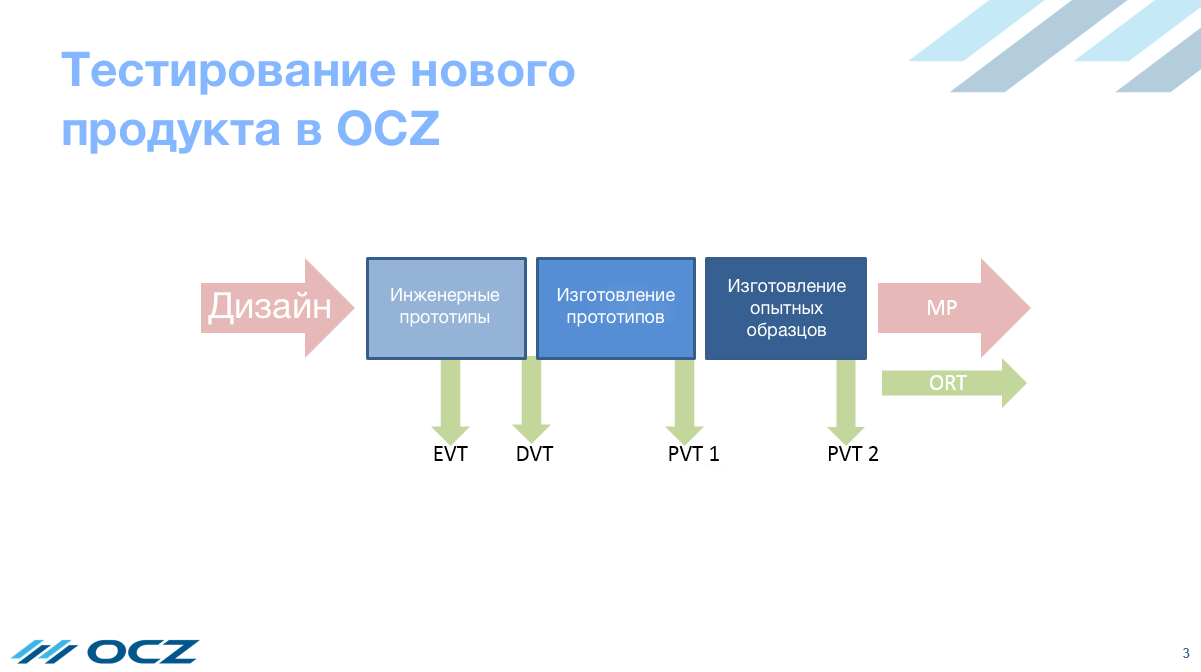
EVT shows how the drive works in real conditions, and whether it matches what was written on paper. The set of parameters for the test is relatively simple: power level, response, speed of operation, otherwise one cannot make sure that the prototype is working as planned.
DVT is divided into two phases: the “normal” test and the quality / reliability test. "Normal" DVT consists of a wider set of tests than EVT, and shows how the drive behaves in different conditions. Each test typically runs on at least four prototypes, while EVT runs on one or two. In general, DVT is an aggregator of dozens of different tests, including a test for compliance, data retention period, power loss, and so on.
Why DVT consists of two parts? The fact is that EVT and “normal” DVT are made by the engineering team (who also designed the drive), so the testing process may cause conflicts of interest and the human factor - people like to close their eyes to their own mistakes. Therefore, a quality / reliability test is carried out by an independent quality control team. Such tests take much more time and are conducted on more devices than EVT.
Production verification test is needed not so much to test the reliability of the drive, but rather to test the production processes. Simply put, the main goal of PVT is to ensure that each disc from the production line is of the same (high) quality. To do this, any disk is taken from the line and checked for various defects caused by soldering. Also, PVT is used to assess the quality system of the plant, including even inspecting the boxes. Next, another test (ORT) is conducted, which tests several disks from different production lines.
The total duration of the testing phase varies from two months to six months or even a year. In the first case - if the design of the disk is relatively simple and similar to previous drives. Until the SSD passes all the testing stages, it will not proceed to the next stage, mass production will not start. Consequently, buyers will not see it.
After the final PVT tests, the conformity of the disc to be made to the declared specifications is confirmed. As soon as the stage is passed, the mass production of SSD begins. Where does all the "magic" happen?
The OCZ plant is located in Zhongli, a district of the city of Taoyuan in the northwestern part of Taiwan, a 45-minute drive from Taipei. Formally, the factory is owned by Powertech - it was sold last after the deal with Toshiba. Powertech is a respected player in the manufacturing industry, with contracts with many companies, including Apple. In addition, this company has built good relationships with both OCZ and Toshiba.
Two technological lines of surface mounting completely belong to OCZ and produce about 70 thousand devices per month. If suddenly there is high demand for storage, the company also uses other lines, in the future OCZ expects to increase production capacity. But let's see how the SSD is actually assembled.
The production of solid-state drives practically does not differ from the assembly of any other component built on a printed circuit board.
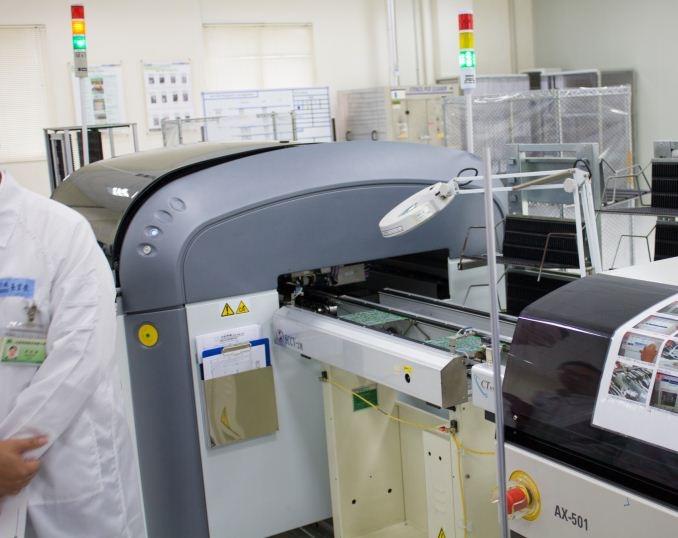
It all starts with the production of the PCB itself (hello, "electronic" silicon!), Which is covered with a chip using solder paste, a mixture of small particles of tin and flux. This happens in the car, which is shown in the photo above.
Solder paste should be stored at a temperature close to zero degrees Celsius, otherwise it will lose its adhesive properties. Therefore, it is stored in small banks in refrigerators.

Finished board with chips can be seen in the photo below. At the same time, four 2.5-inch form factor boards can be produced.
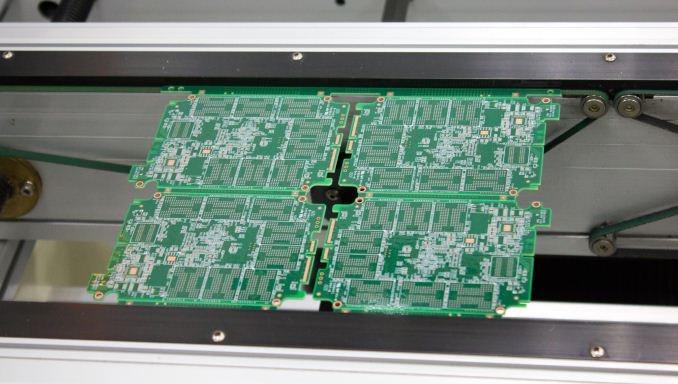
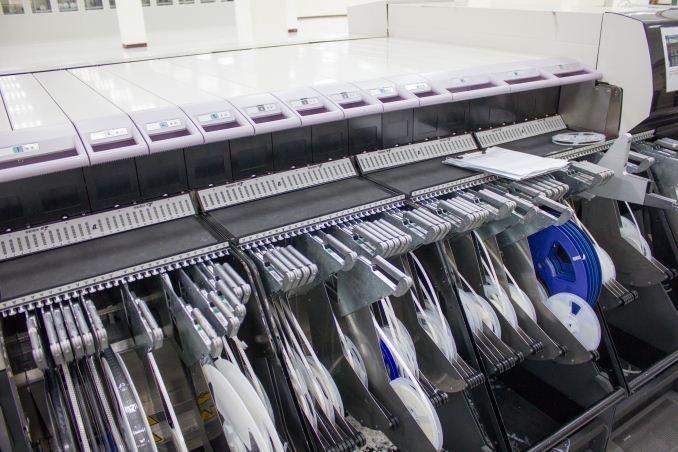
The printed circuit board is ready to “accept” the chips that are installed with this machine. Each chip and resistor is loaded into the "tape and drum" of the machine, which automatically mounts all the components to the right places on the printed circuit board.
The controllers are located in another tray - this is the last component that is installed on the circuit board before the next stage.

Once all the components are assembled, the drive is sent to a special “furnace” that melts the paste and provides electrical connection between all the chips. This process takes about five minutes, while the temperature first increases sharply, and then, at the last stage, decreases. The exact temperature profile is unique and was developed by OCZ engineers, but sometimes it has to be adjusted - by trial and error, so to speak.

After melting, the boards arrive at an automatic visual inspection, where the produced board is compared with the image of the ideal board — thus, it is possible to avoid errors like incorrectly installed chips. Blindly rely on automation in this case is not worth it, so just in case this stage is controlled by the employee. For double-sided printed circuit boards, the entire process from printing to visual inspection, respectively, is repeated, so single-sided boards are usually used in small capacity SSDs. This reduces the cost and cost of storage for the end user.
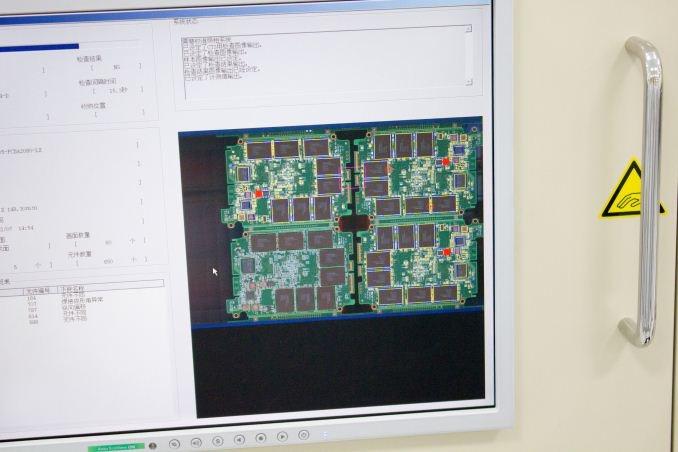
At the final stage, the board is connected to the SATA and power connector. Sometimes the latter is integrated into the board, but often it is located separately. When this process is complete, the boards are separated and cut out of the frame. After that, it is placed in a metal case and screws are screwed in - this unit is responsible for this:

When the hardware part is finished, the software time.
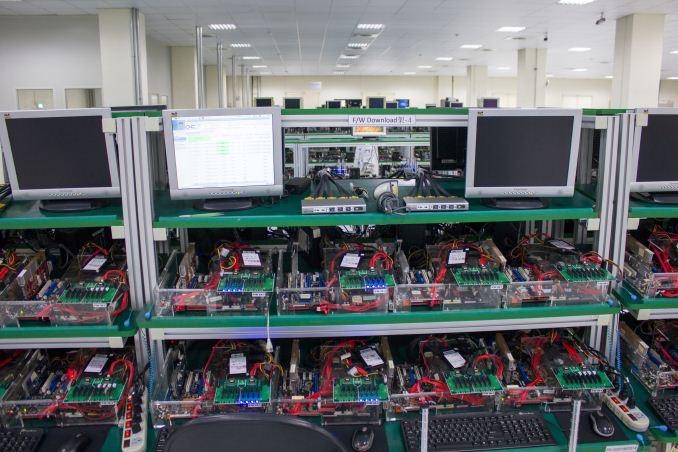
Firmware download is performed by special computers with quite ordinary hardware, Linux is used as the operating system with the software download utility from OCZ installed. In the picture above, for example, software is installed for SSD ARC 100 with a capacity of 240 GB.
As soon as the firmware is loaded, the drives must be tested again. OCZ has developed a special script that exposes the SSD to read and write at least eight times to identify bad blocks. If a marriage is detected, the drive is either sent back for revision, or, as happens much more often, it is simply destroyed. Scripts also test performance using benchmarking tools such as AS-SSD and ATTO. After all, we must make sure that the SSD meets the stated specifications.
Now OCZ has two types of testing. In the first case, these are ordinary computers, which we saw a little earlier, in the second - large cabins with stands, which can check 256 drives at a time. The second option is preferable and faster, but they do not always manage to use it.

For PCIe drives, OCZ has developed an even more advanced type of testing - production self-diagnosis. On the SSD installed custom software that performs the processes of reading and writing. In this case, everything is faster, since all I / O commands are generated by the controller or firmware.
In addition, every month one of the drives produced is sent to a “compliance test” to check the product quality level. At this time, SSD is subjected to sudden temperature changes, including up to 70 degrees Celsius. This allows you to measure the life of the drive in extreme conditions - it should not differ from the stated.

The testing process has not changed much since the moment of the deal with Toshiba, but it is worth noting that Toshiba still helped OCZ to set quality standards. All processes subjected to SSD, approved by the "parent" company and meet its requirements. Each drive is monitored very strictly, and this, of course, had a positive effect on the quality of the OCZ SSD. You yourself were convinced of this - the selection is almost like an astronaut.
Exactly how could we forget. Only if the SSD successfully passed all the tests, meets the stated specifications, works without complaints and without errors, is it ready to go in the package. First, branded stickers are stuck on the drive - now employees do it manually, but very soon the process will be automated.
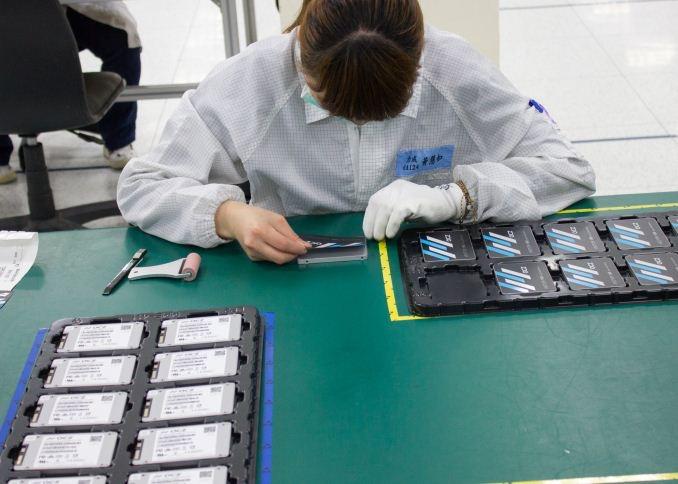
Come quickly in the box! This car is responsible for packing SSD into a beautiful cardboard box:

At the next stage, the drives and accessories are packed in a plastic shell - it is sealed under high temperature.

Retail drives are shipped in large boxes that hold 10 drives at once. The black backing protects the SSD from dropping the box or other external impact - this ensures that the drives are safely and safely stored in the store. To check this, OCZ even conducted special drop tests.

The boxes are sealed and sent to temporary storage, from where the SSD then gets on the shelves.

We admit, the attitude of OCZ to the quality of its drives has completely changed. In the past, it was unheard of that the device could “hang” for three months at the development stage, before entering mass production. Now, the duration of the stages is increased several times, so that the company would not be ashamed of one of its drives. When it comes to quality, we have nothing to hide. Yet from silicon to SSD, the path is not at all short, you yourself saw it. We hope it was interesting.
Before you - metallic silicon. That it is the basis of the production of chips, including components for solid-state drives. Now it is often made by a carbothermic method, which is patented by Russian scientists, using in the process ore-thermal furnaces. A ton of such good costs from two to three thousand euros. In the huge furnaces in the factories get metallic silicon, the purity of which ranges from 98.5%, as well as silicon dust. The latter is used, as a rule, in building mixtures, so that it interests us little.

Technical silicon is obtained by reducing coke with a melt of SiO2, and the temperature reaches 1800 degrees Celsius. Thus, silicon is produced with a purity of 99.9%, where the rest is carbon and metals.
')
But for the production of electronic components, we need the so-called electron silicon, “the purest diamond” among silicon. Technical silicon is chlorinated and trichlorosilane (SiHCl3) is obtained. After it is cleaned, we have electron silicon at the outlet, in which the concentration of impurities is very low — as a rule, 0.0000001%. Electron silicon is melted into single crystals, which are subsequently cut into plates with a diamond saw.
This is what one such single crystal looks like, the weight of which can reach one centner, or even more.

Schematically, the cutting looks like this, saw, believe me, is very sharp:

After that, the plates are polished and made even so that they shine straight in the literal sense. But let's not go deep into the subtleties of production, especially since we simply do not have enough ink to describe all the processes. To demonstrate all this in practice, it is better to look at the production with your own eyes. At the OCZ factory.
Introduction and essence of the SSD manufacturing process
Until our “plane” landed in Taiwan, let's first see how the process of manufacturing solid-state drives in OCZ is structured. Before the disk is in the factory for assembly, it is designed, the design is approved, tested, and many concepts are created. The diagram below illustrates the main stages of the design of the technological part.

As in the case of any product, the development of SSD begins with an idea that may not necessarily be the creation of a completely new model of drive. This could be an update to the existing lineup with a new NAND, its completion with a larger capacity version, another form factor, new software, and so on. At the zero stage, the idea is ready to become a concept; it only needs to be “pushed” in the right direction. This will help the document, which usually consists of 1-2 pages, which contains a brief description of the product and the purpose of its creation.
Once the concept is settled, marketing and engineering teams join forces. Both are very important, because the drive must not only be sold, but also be reliable and modern, combining the latest achievements in the industry. The work takes about three weeks and ends with the formation of requirements and a description of the system. If the latter cannot be formulated, the product returns to the concept stage.
At the second stage, OCZ plans and allocates resources for the project, only after that work on its implementation begins. Two important documents that are needed for this are marketing requirements and an engineering conclusion. In general, the second stage is one of the most important, since it requires teams to work together and work out all aspects and subtleties, including the budget. It depends on the project plan and budget where the company will send its hundreds of thousands (or even millions) of dollars, so there can be no miscalculation here. The second phase depends both on the product and on the teams that work on it: it usually takes from one to three months (the last - in the case of the development of a completely new drive).
If the project budget is allocated, OCZ moves to the third phase, where most of the work of engineers has already been done. The main goal is to create the first working prototype so that it can be tested.
While the engineers are busy with their work, the rest of the teams perform their own tasks and prepare everything for the production of prototypes (at this stage suppliers are selected, preliminary specifications and marketing materials are developed). The length of the development and implementation phase largely depends on the product, but even a drive using an existing controller can be stuck on it for a whole year. It takes several years to develop a completely new controller (for example, JetExpress).
The fourth phase, which includes the analysis and assessment of quality, consists of three main parts: engineering verification test (EVT), design verification test (DVT) and production verification test (PVT).

EVT shows how the drive works in real conditions, and whether it matches what was written on paper. The set of parameters for the test is relatively simple: power level, response, speed of operation, otherwise one cannot make sure that the prototype is working as planned.
DVT is divided into two phases: the “normal” test and the quality / reliability test. "Normal" DVT consists of a wider set of tests than EVT, and shows how the drive behaves in different conditions. Each test typically runs on at least four prototypes, while EVT runs on one or two. In general, DVT is an aggregator of dozens of different tests, including a test for compliance, data retention period, power loss, and so on.
Why DVT consists of two parts? The fact is that EVT and “normal” DVT are made by the engineering team (who also designed the drive), so the testing process may cause conflicts of interest and the human factor - people like to close their eyes to their own mistakes. Therefore, a quality / reliability test is carried out by an independent quality control team. Such tests take much more time and are conducted on more devices than EVT.
Production verification test is needed not so much to test the reliability of the drive, but rather to test the production processes. Simply put, the main goal of PVT is to ensure that each disc from the production line is of the same (high) quality. To do this, any disk is taken from the line and checked for various defects caused by soldering. Also, PVT is used to assess the quality system of the plant, including even inspecting the boxes. Next, another test (ORT) is conducted, which tests several disks from different production lines.
The total duration of the testing phase varies from two months to six months or even a year. In the first case - if the design of the disk is relatively simple and similar to previous drives. Until the SSD passes all the testing stages, it will not proceed to the next stage, mass production will not start. Consequently, buyers will not see it.
Welcome to the production!
After the final PVT tests, the conformity of the disc to be made to the declared specifications is confirmed. As soon as the stage is passed, the mass production of SSD begins. Where does all the "magic" happen?
The OCZ plant is located in Zhongli, a district of the city of Taoyuan in the northwestern part of Taiwan, a 45-minute drive from Taipei. Formally, the factory is owned by Powertech - it was sold last after the deal with Toshiba. Powertech is a respected player in the manufacturing industry, with contracts with many companies, including Apple. In addition, this company has built good relationships with both OCZ and Toshiba.
Two technological lines of surface mounting completely belong to OCZ and produce about 70 thousand devices per month. If suddenly there is high demand for storage, the company also uses other lines, in the future OCZ expects to increase production capacity. But let's see how the SSD is actually assembled.
SSD Production
The production of solid-state drives practically does not differ from the assembly of any other component built on a printed circuit board.

It all starts with the production of the PCB itself (hello, "electronic" silicon!), Which is covered with a chip using solder paste, a mixture of small particles of tin and flux. This happens in the car, which is shown in the photo above.
Solder paste should be stored at a temperature close to zero degrees Celsius, otherwise it will lose its adhesive properties. Therefore, it is stored in small banks in refrigerators.

Finished board with chips can be seen in the photo below. At the same time, four 2.5-inch form factor boards can be produced.


The printed circuit board is ready to “accept” the chips that are installed with this machine. Each chip and resistor is loaded into the "tape and drum" of the machine, which automatically mounts all the components to the right places on the printed circuit board.
The controllers are located in another tray - this is the last component that is installed on the circuit board before the next stage.

Once all the components are assembled, the drive is sent to a special “furnace” that melts the paste and provides electrical connection between all the chips. This process takes about five minutes, while the temperature first increases sharply, and then, at the last stage, decreases. The exact temperature profile is unique and was developed by OCZ engineers, but sometimes it has to be adjusted - by trial and error, so to speak.

After melting, the boards arrive at an automatic visual inspection, where the produced board is compared with the image of the ideal board — thus, it is possible to avoid errors like incorrectly installed chips. Blindly rely on automation in this case is not worth it, so just in case this stage is controlled by the employee. For double-sided printed circuit boards, the entire process from printing to visual inspection, respectively, is repeated, so single-sided boards are usually used in small capacity SSDs. This reduces the cost and cost of storage for the end user.

At the final stage, the board is connected to the SATA and power connector. Sometimes the latter is integrated into the board, but often it is located separately. When this process is complete, the boards are separated and cut out of the frame. After that, it is placed in a metal case and screws are screwed in - this unit is responsible for this:

Software installation
When the hardware part is finished, the software time.

Firmware download is performed by special computers with quite ordinary hardware, Linux is used as the operating system with the software download utility from OCZ installed. In the picture above, for example, software is installed for SSD ARC 100 with a capacity of 240 GB.
As soon as the firmware is loaded, the drives must be tested again. OCZ has developed a special script that exposes the SSD to read and write at least eight times to identify bad blocks. If a marriage is detected, the drive is either sent back for revision, or, as happens much more often, it is simply destroyed. Scripts also test performance using benchmarking tools such as AS-SSD and ATTO. After all, we must make sure that the SSD meets the stated specifications.
Now OCZ has two types of testing. In the first case, these are ordinary computers, which we saw a little earlier, in the second - large cabins with stands, which can check 256 drives at a time. The second option is preferable and faster, but they do not always manage to use it.

For PCIe drives, OCZ has developed an even more advanced type of testing - production self-diagnosis. On the SSD installed custom software that performs the processes of reading and writing. In this case, everything is faster, since all I / O commands are generated by the controller or firmware.
In addition, every month one of the drives produced is sent to a “compliance test” to check the product quality level. At this time, SSD is subjected to sudden temperature changes, including up to 70 degrees Celsius. This allows you to measure the life of the drive in extreme conditions - it should not differ from the stated.

The testing process has not changed much since the moment of the deal with Toshiba, but it is worth noting that Toshiba still helped OCZ to set quality standards. All processes subjected to SSD, approved by the "parent" company and meet its requirements. Each drive is monitored very strictly, and this, of course, had a positive effect on the quality of the OCZ SSD. You yourself were convinced of this - the selection is almost like an astronaut.
Wait, what about the packaging?
Exactly how could we forget. Only if the SSD successfully passed all the tests, meets the stated specifications, works without complaints and without errors, is it ready to go in the package. First, branded stickers are stuck on the drive - now employees do it manually, but very soon the process will be automated.

Come quickly in the box! This car is responsible for packing SSD into a beautiful cardboard box:

At the next stage, the drives and accessories are packed in a plastic shell - it is sealed under high temperature.

Retail drives are shipped in large boxes that hold 10 drives at once. The black backing protects the SSD from dropping the box or other external impact - this ensures that the drives are safely and safely stored in the store. To check this, OCZ even conducted special drop tests.

The boxes are sealed and sent to temporary storage, from where the SSD then gets on the shelves.

Instead of conclusion
We admit, the attitude of OCZ to the quality of its drives has completely changed. In the past, it was unheard of that the device could “hang” for three months at the development stage, before entering mass production. Now, the duration of the stages is increased several times, so that the company would not be ashamed of one of its drives. When it comes to quality, we have nothing to hide. Yet from silicon to SSD, the path is not at all short, you yourself saw it. We hope it was interesting.
Source: https://habr.com/ru/post/372061/
All Articles